At the end of 2015, the population of Israel was 8.5 million. According to the Central Bureau of Statistics, the population is expected to reach 10 million inhabitants at the end of 2024, to 15 million inhabitants at the end of 2048, and at the end of the forecast period, in 2065, it is expected to reach 20 million inhabitants.
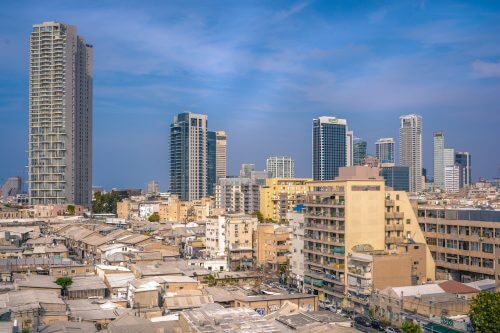
Key points from the CBS report:
- No significant changes are expected in the composition of the general population in the division between Jews and others and Arabs. The share of the Jewish and other population in 25 years (the year 2040) is expected to remain similar to its share in 2015 (79%) and so is the share of the Arab population (21%). In 50 years (the year 2065) the share of the Jewish and other population is expected to increase to 81%, the share of the Arab population is expected to decrease to 19%.
- The share of the ultra-orthodox population is expected to increase From 11% of the total population in Israel in 2015 to 20% in 2040 and to 32% in 2065. Out of the group of Jews and others, the ultra-Orthodox population is expected to increase from 14% in 2015 to 24% in 2040 and to 40% in 2065 .
- The composition of the population of children aged 14-0 is expected to change; In 2015, the share of Jews and others in the population of children aged 14-0 was 75%, of which 19% were ultra-Orthodox. In 50 years, the share of Jews and others will increase to 84% of the child population, of which 49% are ultra-Orthodox. The share of the Arab children's population, which constituted 25% of the 14-0 year olds in 2015, will drop to 15% in 50 years.
- The composition of the working-age population (64-25) is also expected to change: In 2015, the share of Jews and others of working age was 81.2%, of which 7.5% were ultra-Orthodox. At the end of the forecast period, a sharp increase in the share of working-age ultra-Orthodox is expected to reach 26.0%. The share of Arabs of working age is expected to increase from 18.8% to 21.8%.
- The aging process continues in Israel. In 2015, 11.1% of the population was aged 65 or older (939 thousand people). In 2040, the share of people aged 65 and over is expected to increase to 14.3% (1.9 million people) and in 2065 - to 15.3% (3 million people).
- The aging process intensifies in the very old ages. The share of people aged 85 and over in the total population aged 65 and over is expected to increase from 13% in 2015 to 18% in 2040 and to 24% in 2065. The share of people aged 85 and over in the total population is expected to increase from 1.4% in 2015 to 2.5% in 2040 and to 3.6% in 2065.
The population forecast prepared by the Central Bureau of Statistics was based on the population estimates for the end of 2015. This forecast replaces the previous forecast made based on the population at the end of 2010. The previous forecast was made for a period of 25 years (2035-2010) in 5-year age groups and in 5-year periods, With a breakdown for the following population groups: Jews and others, Jews, Muslims, Arab Christians and Druze.
In light of user demand, the range of the forecast was extended to 50 years, the forecast was made according to a single age and a single year, and the population groups determined for the forecast were changed to the following groups: Jews and others (without ultra-Orthodox), ultra-Orthodox and Arabs. The ultra-orthodox population has no official definition. The basis for the estimate of the ultra-Orthodox population is the self-definition as studied in the social survey conducted by the CBS between 2014-2002 with the completion of information from the population registry. The forecast made does not take into account possible transitions between the ultra-orthodox population and the rest of the Jewish population. For these reasons, this estimate may be inaccurate.
The population forecast presented here does not pretend to predict the future. Its main purpose is to provide a general framework for decision makers in Israel for planning purposes. for example:
- The National Economic Council relies on the forecast for the purpose of calculating regional population forecasts that form the basis for regional planning by government bodies, in accordance with Government Resolution 2457 (Dar/131) of March 2017.
- The National Insurance Institute that uses the long-term population forecast for Israel for the purpose of determining future demographic assumptions used to prepare the full actuarial report, the balance sheet and the financial report of the institution.
- The research division of the Bank of Israel uses the population forecast to formulate policy recommendations and analyzes that depend on Israel's future demographic situation, and in particular in a project to forecast the economic growth of the Israeli economy in the long term and in long-term analyzes of policy measures in the areas of the budget, welfare, the electricity sector and infrastructure.
The results of the forecast are the imposition of possible scenarios for future changes in the population starting in 2015. These scenarios were built based on past trends by using statistical models, consultations with experts on the subject and accompanied by an advisory committee established specifically for this purpose on behalf of the Public Council for Statistics. In this announcement, we focus on presenting the findings according to the medium alternative, when presenting the findings according to this alternative, the results of the high alternative and the low alternative must also be taken into account, which present a reasonable range of uncertainty in the realization of the medium alternative.
It is important to note the mutual relationship between the results of the population forecast and the planning factors. On the one hand, the population forecast affects the planning, on the other hand, the planning affects the future and causes a change in reality as measured in the forecast. Therefore, the Central Bureau of Statistics usually updates the forecast once every five years.
The composition of the population
At the end of 2015, the population of Israel was 8.5 million. The population is expected to reach 10 million inhabitants at the end of 2024, to 15 million inhabitants at the end of 2048, and at the end of the forecast period, in 2065, it is expected to reach 20 million inhabitants. For comparison, 50 years ago, in 1965, the population of Israel numbered 2.6 million people. Since 1965 until today, the population has tripled. In the next 50 years, until 2065, the population is expected to double. Table 1 shows the forecast results according to the three alternatives.

The population of Jews and others numbered 2015 million people at the end of 6.7. In 25 years, in 2040, this population is expected to number about 10 million people. In 50 years it is expected to number about 16 million people.
In the next 25 years, the share of the Jewish and other population of the total population is expected to remain stable at around 79%, as it was in 2015. In 50 years, the share of the Jewish and other population is expected to rise to 81%.
The share of the ultra-Orthodox population is expected to increase from 11% of the total population in Israel in 2015 to 20% in 2040 and to 32% in 2065. Of the Jewish and other population, the ultra-Orthodox population is expected to increase from 14% in 2015 to 24% in 2040 and to 40% in 2065.
At the end of 2015, the Arab population numbered 1.8 million people. In 2022, the total population is expected to number about 2 million people. In thirty years, in 2045, the Arab population is expected to number about 3 million people and towards the end of the forecast period, in 2065, the Arab population is expected to number 3.8 million people.
In the next 25 years, the Arab population's share of the total population is expected to remain stable at around 21%, as it was in 2015. In 50 years the share of the Arabs is expected to drop to 19%.
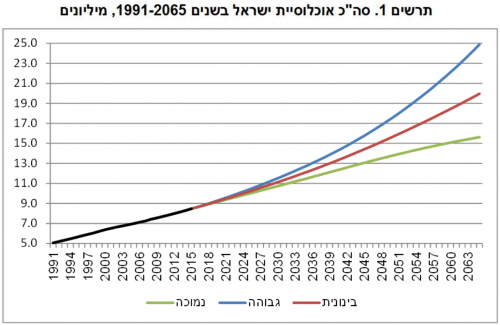
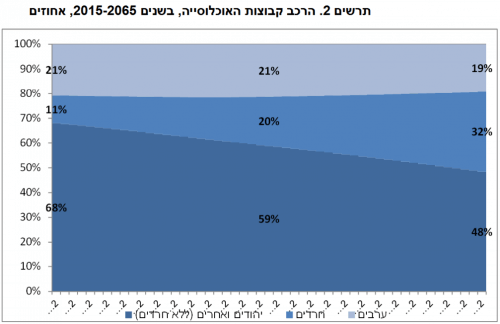
The age composition of the population
Children aged 14-0
At the end of 2015, the number of children up to the age of 14 was 2.4 million, which constituted 28% of the total population of Israel. They are expected to number about 3.7 million children at the end of 2040, and 5.5 million at the end of 2065. Their relative share in the population is expected to remain around 28% throughout the forecast period.
Despite the stability in the share of children aged 14-0 in the total population, there are expected to be changes in the composition of the population at this age. At the end of 2015, 75% of the children were Jews and others (56% non-Orthodox Jews and others and 19% were Orthodox) and 25% were Arabs. In diagram 3 you can see the expected change in the 14-0 team in 25 years and in 50 years. The share of Jewish and other children (without ultra-Orthodox) is expected to drop to 35% in 50 years. The Arab share of the child population is also expected to decrease and reach 15% in 2065. At the same time, the share of ultra-Orthodox children in 2065 is expected to increase to 49%.
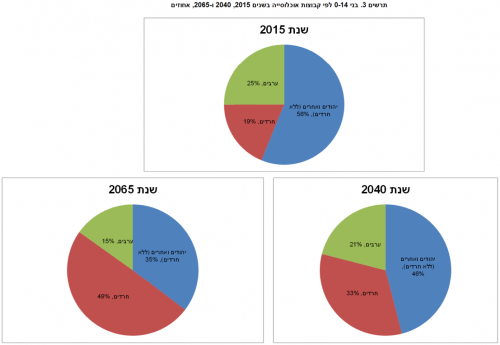
People of prime working age (64-25)
At the end of 2015, the number of people of prime working age (64-25) was 3.9 million people, which constituted about 45% of the entire population of Israel. This group is expected to number about 5.6 million people at the end of 2040, and 8.3 million at the end of 2065. Their relative share in the population is expected to change somewhat - 42.4% and 41.8% in 2040 and 2065, respectively.
In 2015, the share of Jews and others of working age was 81.2% (73.7% non-Orthodox Jews and others and 7.5% ultra-Orthodox) and the share of Arabs was 18.8%. The share of Jews and others is expected to decrease to 78.2% in 2065, at the same time the share of Arabs is expected to increase to 21.8%. The most notable change is the expected sharp increase in the share of working-age ultra-Orthodox, their share is expected to rise to 26.0% at the end of the forecast period.
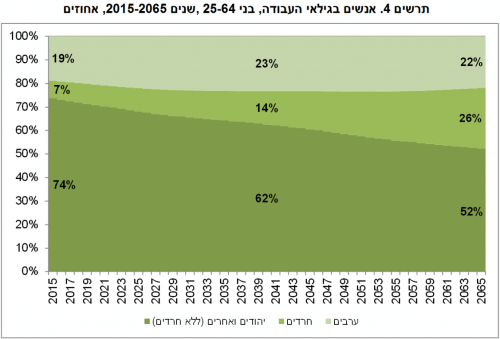
Aging population - age 65 and over
At the end of 2015, the population aged 65 and over numbered 939 thousand people (11.1% of the total population). In recent years, the aging process of the population in Israel has accelerated. The population aged 65 and over is expected to number 1.9 million people in 2040 (14.3% of the total population) and 3.0 million people in 2065 (15.3% of the total population).
At the end of 2015, 89% of all people aged 65 and over were Jews and others (excluding ultra-Orthodox), 3% were ultra-Orthodox and 8% were Arabs. At the end of 2040, the group aged 65 and over is expected to be: Jews and others (without ultra-Orthodox) - 79%, ultra-Orthodox - 6% and Arabs - 15%. At the end of 2065, the composition of this group is expected to be: Jews and others (without ultra-Orthodox) - 68%, ultra-Orthodox - 11% and Arabs - 21%.
The aging process intensifies in the very old ages. The share of those aged 85 and over in the total of those aged 65 and over is expected to increase from 13% in 2015 to 18% in 2040 and to 24% in 2065. The share of people aged 85 and over in the total population is expected to increase from 1.4% in 2015 to 2.5% in 2040 and to 3.6% in 2065.
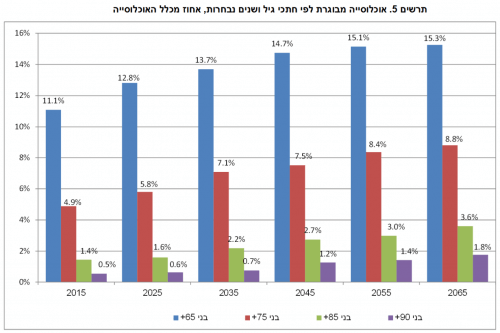

7 תגובות
Dime manipulation... what are Jews and others?! Already today, February 2022, Jews alone number only 73.9% and are decreasing!
It was possible to convert another 5% of the others, but the ultra-Orthodox oppose any conversion that is not strictly orthodox!
The percentage of ultra-Orthodox is expected to increase and eventually, the percentage of Zionist Jews on whom the entire infrastructure of the state is built (army, economy, technology, etc.) will decrease...
In 2065 there will be a non-Zionist majority of Haredim and Arabs...
Unequivocally the end of the Zionist state!
Question: Are there statistics that show population growth by age (infants, children, youth, adults, old people (or alternatively, by age))?
I mean the style of diagram 5 at:
https://www.hayadan.org.il/the-population-of-israel-is-projected-to-reach-20-million-by-2065
By 2065 there will be 45 percent ultra-Orthodox. God forbid, the country can be closed.
Free people will fly to Berlin, Canada and other places. Welcome Iran
Orthodox society will of course change in certain areas. The process of technological integration will increase. The inability to finance a growing public leads them to the world of employment. And since they are a learning and focused company, after a difficult process they will take strong positions in the world of employment. In absolute numbers, the number of Torah learners will not decrease, and will even increase, but in percentage terms, the number of men going out to work will increase significantly. It makes sense that the number of children per woman will decrease, because it is an unacceptable number in the world, but not in very sharp dimensions. The reason: contentment with little is an essential part of this society. When the salaries increase they will be able to give more to the children. Those who have seen contentment with the ultra-Orthodox minority can understand the source of strength if it is by choice, and the place of weakness if it is out of no choice.
to the first responder. There is no reason to change the status of the ultra-orthodox woman. The ultra-Orthodox woman is in a superior position right from the start.
For 2500 years the ultra-Orthodox (Pharisee) population has not changed. Empires came and went, sects of Jews arose and disappeared... and it doesn't matter that the Prussian ultra-Orthodox occupier has existed in the same format without change for thousands of years.
All this while there will be no changes at all in the average birth of all sectors.
I don't think that will be the case. In my opinion, we will see a big change in the status of ultra-Orthodox women in the coming decade, and as a result, a drop in birth rates to values more similar to the national religious public.
Although it may seem that the condition of the ultra-Orthodox woman is worse than ever, because both the burden of earning a living and the social norm is that of having a very large number of children. The ultra-orthodox woman is really under a lot of pressure. But there is also another side, ultra-Orthodox girls mostly study core studies unlike boys, they are more educated and also become more financially independent. Eventually there will be some kind of upheaval. Apart from that, Shivin's values penetrate more and more into the sector. Both by the Internet and by converts who always have something left of the values they brought with them (what in sociology is called socialization agents. People who transfer ideas and values from place to place)
Raphael, I don't think you'll agree with me, but I'd still like to hear your opinion.
The title should be: By 2065, the demographic composition of Israel will change. And my interpretation, not the way we wanted it to be. Not a second Iran. Such an Israel would be ready to be swallowed up by its neighbors. In the long run, the Jewish people will continue to diminish if they do not have independence. Irrationality will defeat logic through the womb. All the futuristic technological predictions given on the site do not perceive Israel as such.